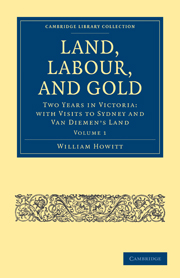Summary
“Upper Yackandanda, Feb. 28th, 1853.
We have begun to destroy the beauty of this creek. It will no longer run clear between its banks, covered with wattles and tea-trees, and amongst its shallow parts over-grown with foreign-looking shrubs, flags, and cypress-grass. A little while, and its whole course will exhibit nothing but nakedness, and heaps of gravel and mud. We diggers are horribly destructive of the picturesque.
The creek runs about fifty yards to the left of our tent, and is, perhaps, some ten or a dozen feet across; but the stream only occupies part of this space, running amongst thickets of the afore-mentioned shrubs. Well, we set to work in earnest as soon as our tent was complete. This is what may be called surface-digging, for the gold lies near the surface of the bottom of the creek; and, indeed, we find it hanging in the roots of the shrubs that we pull up from the spaces that stand above the water. But the main quantity of gold in this stream is found to lie on a layer of clay about two feet below the surface. On this lies mud; and in this mud there is more or less gold. We have no need, therefore, to dig holes of from ten to eighty feet here.
Our first business was to select a portion of the creek where, from its slope, from natural obstructions in it or otherwise, it appeared likely that the gold would lodge.
- Type
- Chapter
- Information
- Land, Labour, and GoldTwo Years in Victoria: with Visits to Sydney and Van Diemen's Land, pp. 205 - 226Publisher: Cambridge University PressPrint publication year: 2011First published in: 1855

